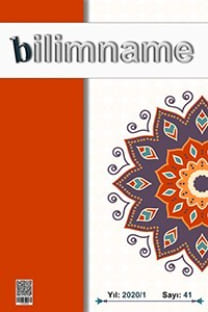Kavlî ve Fiilî Hadisler Arasında Teâruz Problemi ve Çözüm Yolları
Hadis, Fiil, İhtilaf, Mutekaddimûn, Müteahhirûn
The Problem of Contradiction between Verbal and Practical Hadiths and Solutions
Hadith, Action, Contradiction, Earlier Scholars, Later Scholars,
___
- AHMED B. HANBEL, eş-Şeybânî. Müsned. 45 Cilt. Beyrut: Müessesetü’r-Risâle, 1422.
- ALÂÎ, Halîl b. Keykeldî. Tafsîlu’l-icmâl fî teâruzi’l-ekvâm ve’l-ef’âl. Kahire: Dâru’l-Hadîs, 1416.
- ÂMİDÎ, Seyfeddîn. el-İḥkâm fî uṣûli’l-aḥkâm. 4 Cilt. Beyrut: el-Mektebü’l-İslâmî, 1402.
- AŞKAR, Muhammed Süleyman. Ef’âlu’r-Resûl ve delâletuha ale’l-ahkâmi’ş-şer’iyye. Beyrut: Müessesetü’r-Risâle, 1424.
- BUHÂRÎ, Muhammed b. İsmâîl b. İbrâhîm. el-Câmiʿu’ṣ-ṣaḥîḥ. thk. Mustafa Dib el-Buğa. 4 Cilt. Beyrut: Dâru İbn Kesîr, 1407.
- CESSÂS, Ebû Bekr Ahmed b. Alî er-Râzî. el-Fusûl fi’l-usûl. Kuveyt: Vizâratü’l-Evkâfi’l-Kuveytiyye, 1414/1994.
- CÜVEYNÎ, Abdülmelik b. Abdillâh b. Yûsuf. el-Burhân fî uṣûli’l-fıḳh. thk. Salah b. Muhammed. 2 Cilt. Beyrut: Dâru’l-Kutubi’l-İlmiyye, 1418/1997.
- CÜVEYNÎ, Abdülmelik b. Abdillâh b. Yûsuf. Nihâyetü’l-maṭlab fî dirâyeti’l-meẕheb. thk. Abdulazîm Mahmûd. 20 Cilt. Beyrut: Dâru’l-Minhâc, 1428.
- ÇAKAN, İsmail Lütfi. Hadislerde Görülen İhtilaflar ve Çözü Yolları. İstanbul: MÜİF Vakfı Yayınları, 1996.
- EBÛ HÜSEYİN EL-BASRÎ. Mu‘temed. Beyrut: Dâru’l-Kutubi’l-İlmiyye, 1413.
- ERUL, Bünyamin. Sahâbenin Sünnet Anlayışı. Ankara: TDV Yayınları, 1996.
- EBÛ YUSUF, Ya‘kūb b. İbrâhîm b. Habîb b. Sa‘d. el-Âsâr. thk. Ebu’l-Vefâ. Beyrut: Dâru’l-Kutubi’l-İlmiyye, 1355.
- EBÛ YUSUF, Ya‘kūb b. İbrâhîm b. Habîb b. Sa‘d. Kitâbü’l-Ḫarâc. Kâhire: el-Matbaatü’s-Selefiyye, 1387.
- GAZZÂLÎ, Ebû Hâmid. el-Müstaṣfâ min ʿilmi’l-uṣûl. thk. Muhammed Abdusselâm. Beyrut: Dâru’l-Kutubi’l-İlmiyye, 1416.
- GÖRMEZ, Mehmet. Sünnet ve Hadisin Anlaşılması ve Yorumlanmasında Metodoloji Sorunu. Ankara: Türkiye Diyanet Vakfı, 1997.
- HATÎB BAĞDÂDÎ. el-Fakih ve’l-mütefakkih. 2 Cilt. Riyad: Dâru’l-Ensâr, 2016.
- HATTÂBÎ, Hamd b. Muhammed b. İbrâhîm b. Hattâb. Meʿâlimü’s-Sünen. 4 Cilt. Habep: Matbaatü’l-İimiyye, 1351.
- İBN ABDİLBER, en-Nemerî. el-İstiẕkârü’l-Câmiʿ . thk. Sâlim Muhammed Atâ. 9 Cilt. Beyrut: Dâru’l-Kutubi’l-İlmiyye, 1421.
- İBN HACER, Ahmed b. Alî b. Muhammed el-Askalânî. Fetḥu’l-bârî bi-şerḥi Ṣaḥîḥi’l-Buḫârî. thk. Şuayb el-Arnaût. 26 Cilt. Beyrut: Dâru’l-Maʿrife, 1379.
- İBN HAZM, Alî b. Ahmed b. Saîd b. Hazm. el-Muḥallâ bi’l-âsâr. 12 Cilt. Beyrut: Dâru’l-Fikr, ts.
- İBN HAZM, Ali b. Ahmed. Saîd b. Hazm. el-İhkâm fî usûli’l-ahkâm. thk. Ahmed Muhammed Şakir. 8 Cilt. Beyrut: Darü’l-Afâki’l-Cedide, ty.
- İBN KUTEYBE, Ebû Muhammed Abdullah b. Müslim b. Kuteybe. Te’vîlu muhtelifi’l-hadîs. Beyrut: el-Mektebü’l-İslâmî, 1419.
- İBN ŞÂHÎN, Ebû Hafs Ömer b. Ahmed b. Osmân el-Bağdâdî. Nâsiḫu’l-ḥadîs̱ ve mensûḫuh. thk. Semîr b. Emîn. Mısır: Mektebetü’l-Menâr, 1408.
- İBNÜ’L-HÜMÂM, Kemâlüddîn Muhammed b. Abdilvâhid b. Abdilhamîd es-Sivâsî. Fetḥu’l-ḳadîr li’l-ʿâcizi’l-faḳīr. 10 Cilt. Beyrut: Dâru’l-Fikr, ts.
- MÂZERÎ, Muhammed b. Alî b. Ömer et-Temîmî es-Sıkıllî. Îżâḥu’l-maḥṣûl min Burhâni’l-uṣûl. thk. Ammâr et-Tâlibî. Dâru’l-Mağribi’l-İslâmî, Ts.
- MÜZENÎ, Ebû İbrâhîm İsmâîl b. Yahyâ b. İsmâîl. el-Muḫtaṣar. 8 Cilt. Beyrut: Dâru’l-Kutubi’l-İlmiyye, 1410/1990.
- ÖZDEMİR, İbrahim. Nebevi fiil ve terklerin anlam ve yorumu. İstanbul: Ensar Yayınları, 2017.
- RÂZÎ, Fahrüddîn. el-Maḥṣûl. thk. Taha Câbir Feyyâz. 6 Cilt. Beyrut: Müessesetü’r-Risâle, 1418.
- SERAHSÎ, Şemsüleimme Muhammed b. Ebî Sehl Ahmed. Uṣûlü’s-Seraḫsî. 2 Cilt. Beyrut: Dâru’l-Ma’rife, ty.
- ŞÂFİÎ, Muhammed b. İdrîs b. Abbâs. İḫtilâfü’l-ḥadîs̱. Beyrut: Dâru’l-Ma’rife, 1410.
- ŞÂFİÎ, Muhammed b. İdrîs b. Abbâs. el-Üm. 8 Cilt. Beyrut: Dâru’l-Maʿrife, 1411.
- ŞÂFİÎ, Muhammed b. İdrîs b. Abbâs. er-Risâle. thk. Ahmed Şâkir. Mısır: Mektebetü’l-Halebî, 1358.
- ŞÎRÂZÎ, Ebu İshâk. et-Tebsire fî usûli’l-fıkh. thk. Muhammed Hasan. Dimeşk: Dâru’l-Fikr, 1403.
- ŞÎRÂZÎ, Ebû İshâk. el-Lümaʿ fî uṣûli’l-fıḳh. Beyrut: Dâru’l-Kutubi’l-İlmiyye, 1424.
- ŞEVKÂNÎ. İrşâdü’l-fuhûl ilâ tahkîki’l-hak min ilmi’l-usûl. 2 Cilt. Beyrut: Dâru’l-Kitâbi’l-Arabî, 1419.
- ŞEYBÂNÎ, Muhammed b. Hasen. el-Asl. thk. Muhammed Boynukalı. Beyrut: Dâru İbn Hazm, 1433/2012.
- ŞEYBÂNÎ, Muhammed b. Hasen. Mebsût, nşr. Ebû’l-Vefâ el-Afgânî. Karataş: İdâretü’l-Ulûm, ty.
- TABERÂNÎ, Süleymân b. Ahmed b. Eyyûb. el-Mu’cemü’l-kebir. 25 Cilt. Beyrut : Dâru İhyai’t-Türasi’l-Arabi, 1984.
- TABERÎ, Muhammed b. Cerîr b. Yezîd.. Câmiʿu’l-beyân ʿan teʾvîli âyi’l-Ḳurʾân. 24 Cilt. Beyrut: Müessesetü’r-Risâle, 1420.
- TAHÂVÎ, Ahmed b. Muhammed b. Selâme el-Ezdî. Şerhü meʿâni’l-âs̱âr. thk. Muhammed Zührî en-Neccâr. Beyrut: Âlemü’l-Kutub, 1414.
- TİRMİZÎ, Ebû Îsâ Muhammed b. Îsâ b. Sevre et-Tirmizî. Sünen. Beyrut: Dâru’l-Garbi’l-İslâmî, 1416.
- YILMAZ, İbrahim. “İslâm Hukukunda Hz. Peygamber’in Fiillerinin Mubahlık (Hu-kukî Serbestlik) Bildirmesi”. Cumhuriyet Ünv. İlahiyat Fak. Dergisi 25/1 (Haziran 2021), 276-292.
- ZERKEŞİ, Muhammed b Bahadır b Abdullah. el-Baḥrü’l-muḥîṭ fî uṣûli’l-fıḳh. Mısır: Dâru’l-Ketbî, 1414.
- ISSN: 1304-1878
- Yayın Aralığı: Yılda 2 Sayı
- Başlangıç: 2003
- Yayıncı: -
Klasik Dönem Fukaha Usûl Eserlerinde Kıyasın Kaynak Değeri
Akif DURSUN, Ahmet Hamdi YILDIRIM
Arap Tiyatrosundan Karşılaştırmalı İki Şehrâzâd
Ebu’l Hasan el-Âmirî'de İdeal Devlet Tasavvuru
Fuat AKPINAR, Ahmet Kamil CİHAN
Çizgi Dışı Bir Evlilik Hikayesi: Müslüman Kadının Gayri Müslim Erkekle Evliliği
Kur’ân Ayetlerinin Anlaşılmasında Tarihsel Arka Planın Önemi: Tefhîmü’l-Kur’ân Örneği
Hadiste Müphem Tevsîk: ‘İtham Etmediğim Kişi’ İfadesine İlişkin Değerlendirmeler
Taha ÇELİK, Mustafa Yasin AKBAŞ
İbn Sînâ’nın İmkân Delili: Doğa Bilimlerinin Sınırı ve Metafizik
Mahmut Sami ÖZDİL, Ahmet Nusret ÖZDİL
Oryantalist William Montgomery Watt'ın Kaderle İlgili Hadislere Yaklaşımına Eleştirel Bir Bakış
Frege’nin Psikolojizm Karşıtlığı ve Bunun Mantığın Konusu ile İlişkisi
